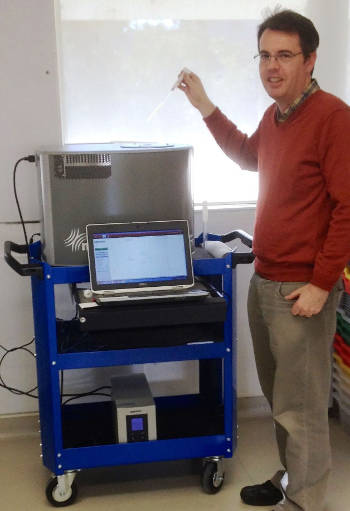Magritek, a leading provider of compact NMR and MRI instruments, report on the use of their Spinsolve Benchtop NMR spectrometer the Chemistry Department of the University of Queensland where it is in use in the undergraduate laboratory curricula.
 Dr Philip Sharpe with his Spinsolve NMR spectrometer on a trolley for easy movement between laboratories.
Dr Philip Sharpe with his Spinsolve NMR spectrometer on a trolley for easy movement between laboratories.
Dr Philip Sharpe is a teaching-focused academic in the School of Chemistry & Molecular Biosciences at the University of Queensland, Australia. His active research interests are in the field of chemistry education research, particularly student learning within the laboratory environment. His goal is to remove the barriers that hinder student success in the laboratory and to provide situations that allow students to maximize their learning.
As the academic in charge of the first year chemistry laboratory, Dr Sharpe is making analytical techniques available to young undergraduates whereas previous students may have had to rely on theory lessons and to use data generated at remote laboratories rather than by the students themselves in the same lab where they may have synthesised their product.
Dr Sharpe has come up with a novel idea. He has his Spinsolve on a trolley which enables him to go from the second floor first year labs up to the fourth floor Advanced Teaching Laboratory and the fifth floor laboratory for second and third year students. This flexibility is great. The students really feel they can now embrace NMR as a usable technique rather than another mystical tale from the chemistry text books.
Commenting about Spinsolve, Dr Sharpe sees many advantages in both teaching and research:
“Students used to miss the link from theory to practical use. Now my groups can have a hands-on experience and understand the value of NMR to the synthetic chemist. My second semester first-year students are taken through the basics of using Spinsolve. They make a product (paracetamol); run it on the NMR; acquire and process the data. Some of our more high achieving undergraduate students go a stage further with a six week research project where they are introduced to spectroscopy – IR, NMR and GC-MS. Each student is allowed to choose their own project. For example it could to study different reactions of benzaldehyde. They will analyse the products they synthesise to look at variations in substitution products. They are taught to use multiple techniques to confirm what they have made and the Spinsolve NMR machine is key to achieving this.”
Because of Spinsolve’s size, the fact that it does not need cryogens and requires just a single power socket means Queensland’ss system is looked on as fully portable and lives on a trolley which is ferried by elevator between floors as and when it is required. As Dr Sharpe says:
“The versatility of Spinsolve is just great. It gives us the flexibility we need. Students and staff alike are very pleased to have access to it.”
#4 Spinsolve Multinuclear Switching (H-F) 2015
#4 Spinsolve Multinuclear Switching (H-F) 2015 from Andrew Coy on Vimeo.
To obtain full details of the Spinsolve benchtop NMR spectrometer and the full range of analytical products from Magritek, visit, www.magritek.com.
About Magritek
Magritek provides complete NMR and MRI solutions and applications for Chemical, Pharmaceutical, Oil and Gas, Food and Construction Industries as well as components and subsystems suitable for Research Laboratories and Academic Education. Magritek has offices in Aachen, Germany, San Diego, USA, and Wellington, New Zealand and a global network of distributors and agents to support customers. The initial NMR technology and IP used in Magritek products grew out of decades of world-class research by Ampere prize winner Professor Bernhard Bluemich's group at RWTH Aachen University, and Gunther Laukien prize winner Paul Callaghan's team at Massey University and Victoria University of Wellington.
For details on Magritek and all its products & solutions, visit www.magritek.com.